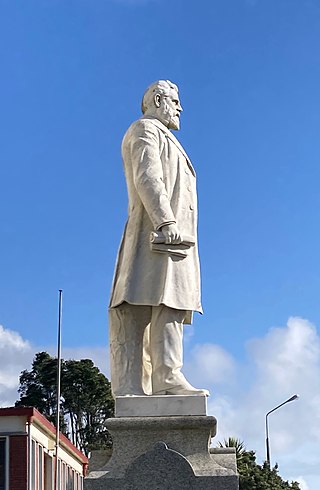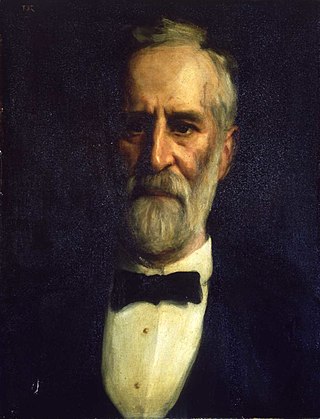
Richard John Seddon was a New Zealand politician who served as the 15th premier of New Zealand from 1893 until his death. In office for thirteen years, he is to date New Zealand's longest-serving head of government.
Kumara was a parliamentary electorate in the West Coast region of New Zealand, from 1881 to 1890.
Hokitika is a former parliamentary electorate in the West Coast region of New Zealand, based on the town of Hokitika. It existed from 1871 to 1890 and was represented by nine members of parliament. For a time, it was one of the two-member electorates in New Zealand.
Westland was a parliamentary electorate in the West Coast of New Zealand from 1866 to 1868 and 1890 to 1972. In 1972 the Tasman and West Coast electorates replaced the former Buller and Westland electorates.

Charles Edward Button was a solicitor, Supreme Court judge, Mayor of Hokitika and later Birkenhead, and an independent conservative Member of Parliament in New Zealand. Born in Tasmania, he came to New Zealand with his wife in 1863. He first lived in Invercargill, then in Westland, and after a brief period in Christchurch, he settled in Auckland. He was an MP for two periods, and when he was first elected to Parliament, he beat his colleague, friend, political opponent, and later Premier Richard Seddon; this was the only election defeat ever suffered by Seddon.

Edwin Blake was a 19th-century Liberal Party Member of Parliament in Canterbury, New Zealand.
Edmund Barff was a 19th-century Member of Parliament from the West Coast, New Zealand.
John Bevan was a 19th-century member of the House of Representatives. He was an auctioneer and merchant from Hokitika on the West Coast of New Zealand.

Gerard George Fitzgerald was a 19th-century Member of Parliament in New Zealand. Like his brother James FitzGerald, he was a journalist of considerable ability, and co-founded The Southland Times in 1862. For the last 19 years of his life, he was editor of The Timaru Herald.

Seymour Thorne George was a New Zealand politician. The premier, Sir George Grey, was his wife's half-uncle and adoptive father, and that relationship resulted in Thorne George representing the South Island electorate of Hokitika despite him being based in the North Island. He later represented the Rodney electorate. Thorne George was later Mayor of Parnell.

Joseph Grimmond was a gold miner and politician from the West Coast, New Zealand. He was mayor of Ross for many years, represented the Hokitika electorate in the House of Representatives for one term, and was later called to the Legislative Council.
Robert Caldwell Reid was a 19th-century Member of Parliament from the West Coast, New Zealand. Born in Scotland and attracted by the gold rushes in Victoria and the West Coast, he was later the proprietor of a series of newspapers.

Westland High School, previously Hokitika High School or Hokitika District High School, is a secondary school in Hokitika, New Zealand.
The Westland Boroughs by-election 1868 was a by-election held in the Westland Boroughs electorate during the 4th New Zealand Parliament, on 3 April 1868.
The Mayor of Hokitika officiated over the borough of Hokitika in New Zealand. The office was created in 1866 when Hokitika became a municipality and a borough two years later, and ceased with the 1989 local government reforms, when Hokitika Borough and Westland County merged to form Westland District. The first Mayor of Hokitika was James Bonar.

Henry Leslie Michel was Mayor of Hokitika for several years, and served on the New Zealand Legislative Council from 1918 until his death. He had stood for the New Zealand Parliament on four occasions, in later years for the Reform Party, but was unsuccessful.

Westland County, also known as County of Westland, was a local government area on the West Coast of New Zealand's South Island. It existed from 1868 to 1873, and then from 1876 until 1989. In its first incarnation, it constituted the government for the area that was split from the Canterbury Province, with the West Coast Gold Rush having given the impetus for that split. It had the same administrative powers as a provincial council, but the legislative power rested with Parliament in Wellington. The first Westland County was the predecessor to Westland Province.

The Hokitika Clock Tower, initially called the Westland War Memorial and then the Coronation and War Memorial, is a prominent landmark in Hokitika, New Zealand. The memorial was initiated, fundraised for, and carried out by a committee, to commemorate the region's contribution to the Second Boer War; not just the four local men who had died but all 130 who had gone to war in South Africa. An additional purpose was to provide Hokitika with a town clock.

This statue of Richard Seddon is in Hokitika, on the West Coast of the South Island of New Zealand. The statue is situated on Sewell Street, outside the Government Buildings known as Seddon House.

Walter Scott Reid was New Zealand's first non-political Solicitor-General and the first elected president of the New Zealand Law Society.















